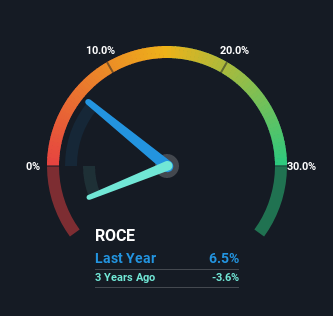If we want to find a stock that could multiply over the long term, what are the underlying trends we should look for? One common approach is to try and find a company with returns on capital employed (ROCE) that are increasing, in conjunction with a growing amount of capital employed. This shows us that it's a compounding machine, able to continually reinvest its earnings back into the business and generate higher returns. Speaking of which, we noticed some great changes in Pulse Oil's (CVE:PUL) returns on capital, so let's have a look.
Return On Capital Employed (ROCE): What Is It?
Just to clarify if you're unsure, ROCE is a metric for evaluating how much pre-tax income (in percentage terms) a company earns on the capital invested in its business. To calculate this metric for Pulse Oil, this is the formula:
Return on Capital Employed = Earnings Before Interest and Tax (EBIT) ÷ (Total Assets - Current Liabilities)
0.065 = CA$1.9m ÷ (CA$31m - CA$1.6m) (Based on the trailing twelve months to June 2022).
Thus, Pulse Oil has an ROCE of 6.5%. Ultimately, that's a low return and it under-performs the Oil and Gas industry average of 19%.
Our analysis indicates that PUL is potentially overvalued!

Historical performance is a great place to start when researching a stock so above you can see the gauge for Pulse Oil's ROCE against it's prior returns. If you're interested in investigating Pulse Oil's past further, check out this free graph of past earnings, revenue and cash flow.
What The Trend Of ROCE Can Tell Us
We're delighted to see that Pulse Oil is reaping rewards from its investments and is now generating some pre-tax profits. About five years ago the company was generating losses but things have turned around because it's now earning 6.5% on its capital. Not only that, but the company is utilizing 357% more capital than before, but that's to be expected from a company trying to break into profitability. This can indicate that there's plenty of opportunities to invest capital internally and at ever higher rates, both common traits of a multi-bagger.
The Key Takeaway
Overall, Pulse Oil gets a big tick from us thanks in most part to the fact that it is now profitable and is reinvesting in its business. Although the company may be facing some issues elsewhere since the stock has plunged 76% in the last five years. Regardless, we think the underlying fundamentals warrant this stock for further investigation.
One more thing: We've identified 5 warning signs with Pulse Oil (at least 2 which are a bit unpleasant) , and understanding them would certainly be useful.
While Pulse Oil isn't earning the highest return, check out this free list of companies that are earning high returns on equity with solid balance sheets.
New: Manage All Your Stock Portfolios in One Place
We've created the ultimate portfolio companion for stock investors, and it's free.
• Connect an unlimited number of Portfolios and see your total in one currency
• Be alerted to new Warning Signs or Risks via email or mobile
• Track the Fair Value of your stocks
Have feedback on this article? Concerned about the content? Get in touch with us directly. Alternatively, email editorial-team (at) simplywallst.com.
This article by Simply Wall St is general in nature. We provide commentary based on historical data and analyst forecasts only using an unbiased methodology and our articles are not intended to be financial advice. It does not constitute a recommendation to buy or sell any stock, and does not take account of your objectives, or your financial situation. We aim to bring you long-term focused analysis driven by fundamental data. Note that our analysis may not factor in the latest price-sensitive company announcements or qualitative material. Simply Wall St has no position in any stocks mentioned.
About TSXV:PUL
Pulse Oil
Engages in the exploration and production of crude oil, natural gas, and natural gas liquid projects in Alberta.
Moderate risk with mediocre balance sheet.
Market Insights
Weekly Picks

Solutions by stc: 34% Upside in Saudi's Digital Transformation Leader


The AI Infrastructure Giant Grows Into Its Valuation
Recently Updated Narratives


Not a Bubble, But the "Industrial Revolution 4.0" Engine


The "David vs. Goliath" AI Trade – Why Second Place is Worth Billions


The "Sleeping Giant" Wakes Up – Efficiency & Monetization
Popular Narratives


MicroVision will explode future revenue by 380.37% with a vision towards success


NVDA: Expanding AI Demand Will Drive Major Data Center Investments Through 2026



